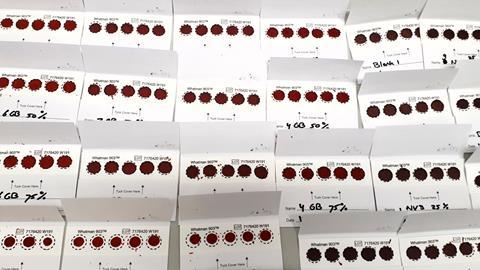Even after three months, you can still find biomarkers for nerve gases in dried bloodspots. And, as Amsterdam researchers show in Forensic Chemistry, you can detect a wider range of substances than previously thought.
Research on chemical weapons - which are on the OPCW’s list of banned substances - is only allowed in one place in the Netherlands, at TNO Defence, Safety and Security. This includes the Novichok nerve agents. ‘There has not been a lot of research done on this yet’ , says Mirjam de Bruin-Hoegée, a PhD student at the University of Amsterdam and at TNO. ‘Our aim with this research was to develop a method by which people in the field – military personnel or doctors – can make a measurement relatively easily, so that it becomes clear quickly whether nerve gases have been involved.’
‘You can take a finger prick yourself and save it for later research.’
To do this, they exposed blood to (small amounts of) different nerve gases. Many of them contain organophosphates, which react in the blood with certain proteins to form biomarkers in the form of protein adducts. ‘So we looked specifically for the biomarkers of sarin and Novichoks, for example’, says De Bruin-Hoegée. ‘But we also looked at whether we could regenerate nerve gases previously bound to the protein by adding fluoride to the blood.’
Failed
The researchers found the latter method in another paper, where it seemed to work. ‘But after endless attempts, it only worked for sarin, not novichok. The problem is that some of the nerve gases do not react in blood. So you cannot use this method as an additional confirmation because it is not so easy to tell whether you are detecting the original gas or the regenerated one.’ The advantage, however, is that the intact novichoks are detectable in the blood for a fairly long time, which you can use as an alternative to prove exposure. So, despite this being a ‘failed’ experiment, information about how not to detect something is important as well.

The detection of chemical warfare agents in blood is not particularly surprising, but what is striking is the fact that even dried bloodspots that are three months old still contain biomarkers. ‘We look at this with a small portable device that measures the activity of cholinesterase enzymes’, explains De Bruin-Hoegée. ‘Nerve gases actually inhibit these enzymes. This is how we discovered that the mobile technique works not only with sarin, but also with the other nerve gases.’ The field measurements can then be confirmed in the laboratory with LC-MS/MS and GC-MS/MS.

Applications
This small device is easy to use in the field, even though it is not really used yet. De Bruin-Hoegée: ‘There are several applications. If you take regular drops of blood from soldiers in high-risk areas, it is easier to find out if someone with symptoms has been exposed to chemical weapons. Or suppose a civilian target has been hit and you can’t investigate it yet for security reasons, then you can take a finger prick yourself as a civilian and save it for later investigation. If there are indications of possible exposure to nerve gas in the field, you can go back to the laboratory to test the bloodspots and confirm the use of these banned substances.’
De Bruin-Hoegée, M. et al. (2023) Forensic Chem. 35, DOI: 10.1016/j.forc.2023.100526













Nog geen opmerkingen